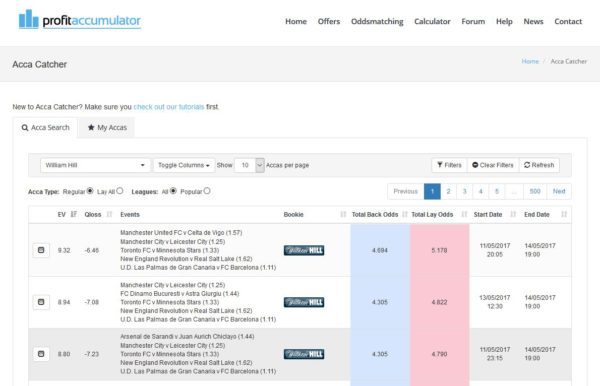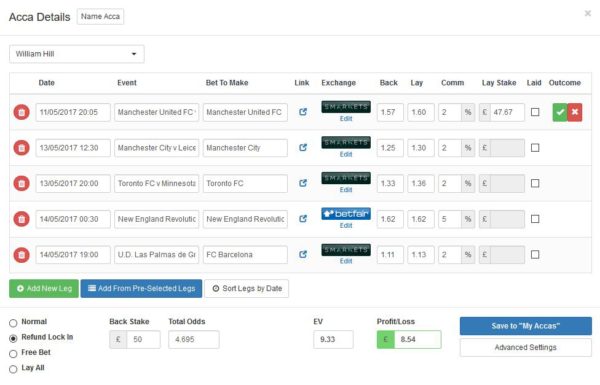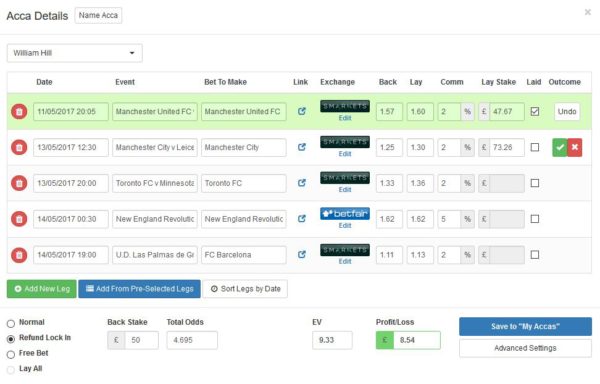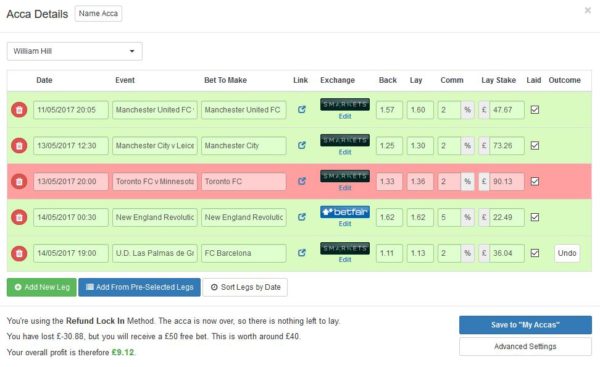Matched Betting: How to Profit from Acca Insurance
I’ve mentioned matched betting a few times on Pounds and Sense. It’s one of my favourite income-generating sidelines.
To recap, matched betting is a risk-free money-making method that involves (legally) taking advantage of bookmaker special offers. By this means you can generate a guaranteed profit for no risk, regardless of how the event/s you are betting on pan out. You can read my post about how matched betting works here, and my post about why I believe matched betting is particularly suitable for over-sixties here.
In my post today I want to talk about a matched betting technique I’ve been using with considerable success recently. This is profiting from acca insurance. Obviously, for the benefit of those new to betting, I need to start by explaining what an acca is.
Table of Contents
What Are Accas?
The term acca is short for accumulator. It is a set of bets (usually four or more) where every bet has to win in order for the acca to succeed and generate a profit. That means accumulators are typically quite risky bets. When one succeeds the returns can be substantial, however, as your winnings are calculated by multiplying all the odds together.
Normally if one leg of an accumulator fails, the whole bet is lost. However, a number of bookmakers offer something called acca insurance with football bets. In this case, if one leg of your acca lets you down, your stake is refunded, generally as a free bet to the same value as the original. By laying off some (or all) of the bets in your acca – and staking carefully – you may be able to take advantage of the ‘added value’ from the insurance to guarantee yourself a profit.
As we shall see there are various approaches you can use, but my clear favourite is the Lock In method. This guarantees a set profit however many legs of your bet fail, from none to all five.
Of course, this profit is less than you would get from a winning accumulator that you didn’t lay off, but as I said earlier accas are risky bets. Using the Lock In method all but removes the risk of losing money (in theory you could still lose if the lay odds on later legs move massively against you, but that is highly unlikely – and much more often the odds actually move in your favour).
Finding accas that will work with this method and calculating the required stakes is not easy if you are working alone. I therefore recommend that you use my favourite matched betting advisory service, Profit Accumulator. They have recently added an online tool called Acca Catcher to the range of resources on offer to Platinum members.
Acca Catcher is an amazing tool that will find accas with insurance for you, show you how much profit they can generate, and reveal exactly what you need to stake on them and when.
About Profit Accumulator
As I have mentioned on Pounds and Sense before, Profit Accumulator is a membership website that provides in-depth tutorials on how to apply matched betting strategies to make money. They also provide special ‘oddsmatching’ software to find suitable bets and calculators to work out the necessary stakes (which is of course crucial).
In recent months Profit Accumulator have added a number of new tools to their Platinum Membership. These include Match Catcher (a tool for those doing horse-racing refunds) and Dutching (a tool for finding arbitrage opportunities among two or more bookmakers). I’ll talk about these in future posts.
As mentioned above, however, the tool that I want to focus on today is Acca Catcher. I will reveal how this works below, though to get full details I highly recommend signing up with Profit Accumulator and watching the training videos they provide.
Using PA’s Acca Catcher
Here is a screen capture of the page that opens when you log in to your Profit Accumulator Platinum account and click on Acca Catcher in the Oddsmatching menu. Obviously, by the time you read this, the accas shown will have changed.

Acca Catcher shows a number of accas you can use with this method. By default they are arranged in order of EV, which stands for expected value. This is a measure of how profitable they should be, so the larger the better is the rule here. As you can see, the top one listed here (with the highest EV) Is with William Hill. This is often the case, as William Hill have the most generous terms and conditions and allow you to stake up to £50 per acca (some other bookies limit you to £25 or less).
The QLoss figure stands for qualifying loss. This only applies if you use what they call the Normal method. In this case you stake in such a way that if you end up with exactly one losing leg in your acca you get a free bet (from which you should be able to generate an 80% profit) and with any other outcome a modest qualifying loss. Using this method, on average you should make a profit equivalent to the EV shown. This is typically slightly higher than the profit available using the Lock In method, but of course it is only an average, and some of the time you will lose money.
Personally I prefer the certainty of the Lock In method even if it might be marginally less profitable overall. You may see this differently, of course.
The other things shown on the opening screen are the actual games in the acca, the total back and lay odds, and the start and end dates of the acca.
One other thing you will notice to the left of each acca is a small calculator icon. This is very important, as if you click on it, it will show you everything you need to know in order to extract a profit from the acca in question. So let;s see what happens when we click on the first of the accas shown…

Note that by default the ‘Normal’ button is selected at the bottom left. As I prefer the Lock In method, however, I have switched it to that.
The calculator now shows you the acca bet you have to make and the first lay. Note that while you place all the back bets together in your accumulator, using the Lock In method you place the lay bets sequentially. This is necessary as the required stake can change depending on whether each leg wins or loses (and after two losing legs with the lock-in method you stop laying).
If we were doing this bet, then, our first step would be to place a £50 acca bet at William Hill containing the five bets shown. We would then lay off the first leg using a lay stake of £47.67, exactly as shown in the calculator.
Once the match has been played and the result is known, we then return to the calculator and click on the green tick on the right if the result was as forecast (in this case a win for Manchester United) or the red tick if it wasn’t (a draw or away win). The calculator then shows us the lay stake we need to place in the next leg (see below).

So we now place a lay bet of £73.26 on Manchester City. This process continues until we reach the end of the acca or there are two losing legs, whichever comes first.
Let’s say for the sake of argument the middle leg of the acca loses but all the others win. The final calculator screen will look like this:

As you can see, because one leg lost, the acca doesn’t pay out and you have made a net loss on it. However, you qualify for a £50 free bet on the acca insurance. By backing and laying the free bet using standard matched betting technique (and the free calculator on Profit Accumulator) you should be able to extract around £40 profit from the free bet. In the example above, as the calculator says, you would therefore end up with a net profit of £9.12. Give or take a few pence, your net profit would be just the same if all five legs won or none of them.
More Acca Insurance Tips
I have set out above the basics of how matched betting with acca insurance works. As I said earlier, I highly recommend watching the training videos on Profit Accumulator to see exactly how it works step by step. Assuming you are a PA Platinum member you can also play about with the software to your heart’s content without spending any money until you are confident with it. Here though are a few more tips to help you on your way…
- Bear in mind that if you can get better odds than those shown in the calculator, the net profit will be boosted. I find that often as a match gets closer the lay odds will go down, making your bet more profitable. You can enter the new lay odds manually and the lay stakes and profit figures will be automatically adjusted.
- Sometimes Acca Catcher shows lay odds from Betfair, other times from Smarkets. I use the latter as much as possible, as their fees are lower and it simplifies matters to lay all your bets in one exchange. In any event, it is often worth checking the other exchange, as you may be able to get a better price there than the one shown on the calculator. Exchange prices change constantly, and if there is plenty of time before the next leg you may want to try entering a lay bet lower than the current offer price in the hope that it will be matched subsequently.
- As mentioned above, an alternative to the Lock In method is the Normal method. With this you aim to have exactly one losing leg in your acca in order to qualify for the refund. With any other outcome (no losing legs or two or more) you suffer a small qualifying loss. With the Normal method, as soon as you have one losing leg in your acca, you stop laying. With the Lock In method, by contrast, you don’t stop laying until you have two losing legs.
- Another option on the calculator is ‘Lay All’. This is where you lay all your selections at the same time (obviously before the first leg starts). This method only works when all the selections are available at extremely short odds (generally no higher than 1.20). The profits vary according to how many legs win – typically you will make a decent profit if all legs win, but if one loses you will make a very small profit or break even. With two or more losing legs the winnings increase again, but at such short odds this is obviously rare. I haven’t bothered with the ‘lay all’ method myself, but the option is there if you want it. It does have the obvious attraction that you can do all your backing and laying at once.
- One thing to watch with accas is that you don’t have more than one ending on the same day. In the case of William Hill (and some others) they will only give you one refund per day – so if you have two accas ending the same day, each with one losing leg, you will only get one refund. That would leave you with a net loss on the other acca, of course.
- As you may gather, I’m a big fan of William Hill, not least as they allow you to stake a generous £50 per acca and have this refunded as a free bet if one leg loses. Using the Lock In matched betting method, I would generally expect to make a minimum of £10 per William Hill acca. I therefore highly recommend using William Hill with this method, but would also advise placing other ‘mug’ bets with them to try to reduce the risk of having your account restricted (or gubbed, as matched bettors say). You can lay off your mug bets to minimize your losses from them.
- Different bookies have different rules about accas, e.g. Ladbrokes only allow insurance up to a maximum stake of £25 and a smaller range of national leagues is eligible. Other bookies specify minimum odds for each leg of your acca, e.g. with Paddy Power the minimum is 1/5 (1.20 in decimal format). Acca Catcher from Profit Accumulator should incorporate any such restrictions into its recommendations, but it never hurts to check if you are uncertain.
- When entering results in the calculator, remember that the outcome that counts is the one at full time (90 minutes). Some cup and international matches have extra time if the teams are drawing after 90 minutes, but the result after extra time isn’t relevant for acca betting purposes.
Good luck with your acca insurance bets. If you have any comments or questions, as ever, please do post them below.



